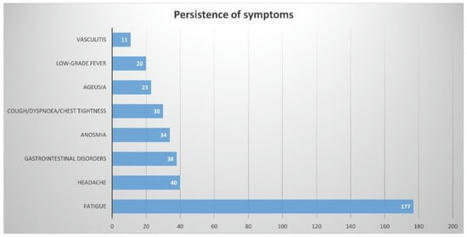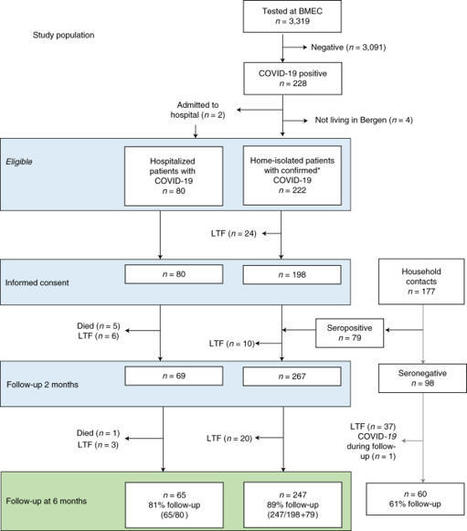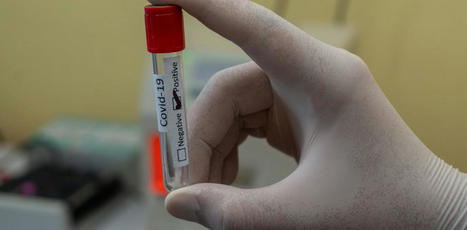 Your new post is loading...

|
Scooped by
HAS-veille
|
There’s no question that vaccines are making a tremendous difference in protecting individuals and whole communities against infection and severe illness from SARS-CoV-2, the coronavirus that causes COVID-19. And now, there’s yet another reason to get the vaccine: in the event of a breakthrough infection, people who are fully vaccinated also are substantially less likely…

|
Scooped by
HAS-veille
|
The persistence of symptoms after recovery from Coronavirus 2019 (COVID-19) is defined as long COVID, an entity that had occurred among adults but which is not yet well characterized in pediatric ages. The purpose of this work was to present some of the data from a survey addressed to Italian pediatricians concerning the impact of long-COVID among children who recovered from severe acute respiratory syndrome coronavirus-2 (SARS-CoV-2) infection. The questionnaire was designed and pre-tested in February 2021 by a working group of experts from the Italian Pediatric Society for Allergy and Immunology (SIAIP). The survey was emailed once in March 2021 to a sample of Italian pediatricians. A total 267 Italian pediatricians participated in our survey. According to most pediatricians (97.3%), the persistence of symptoms is found in less than 20% of children. Specifically, with regard to the symptoms that persist even after swab negativization, fatigue was the most mentioned one (75.6%). Long-COVID would seem to be a phenomenon of limited occurrence in pediatric ages, affecting less than 20% of children. Among all of the symptoms, the one that was most prevalent was fatigue, a pathological entity that is associated with many viral diseases.

|
Scooped by
HAS-veille
|
Long-term complications after coronavirus disease 2019 (COVID-19) are common in hospitalized patients, but the spectrum of symptoms in milder cases needs further investigation. We conducted a long-term follow-up in a prospective cohort study of 312 patients—247 home-isolated and 65 hospitalized—comprising 82% of total cases in Bergen during the first pandemic wave in Norway. At 6 months, 61% (189/312) of all patients had persistent symptoms, which were independently associated with severity of initial illness, increased convalescent antibody titers and pre-existing chronic lung disease. We found that 52% (32/61) of home-isolated young adults, aged 16–30 years, had symptoms at 6 months, including loss of taste and/or smell (28%, 17/61), fatigue (21%, 13/61), dyspnea (13%, 8/61), impaired concentration (13%, 8/61) and memory problems (11%, 7/61). Our findings that young, home-isolated adults with mild COVID-19 are at risk of long-lasting dyspnea and cognitive symptoms highlight the importance of infection control measures, such as vaccination. Analysis of a prospectively enrolled cohort of patients with SARS-CoV-2 infections in Bergen, Norway, reveals a high proportion of patients who experienced long COVID symptoms at 6 months, despite being relatively young and having only mild to moderate acute COVID-19 symptoms.

|
Scooped by
HAS-veille
|

|
Scooped by
HAS-veille
|
Scientists are starting to get insights into the lingering disorder that affects some people infected with SARS-CoV-2 — but many mysteries remain unsolved.

|
Scooped by
HAS-veille
|

|
Scooped by
HAS-veille
|
This systematic review uses data from cohort studies to examine the frequency, variety, and severity of persistent symptoms among individuals with previous COVID-19 infection.

|
Scooped by
HAS-veille
|
In most patients who recovered from severe COVID-19, dyspnoea scores and exercise
capacity improved over time; however, in a subgroup of patients at 12 months we found
evidence of persistent physiological and radiographic change. A unified pathway for
the respiratory follow-up of patients with COVID-19 is required.

|
Scooped by
HAS-veille
|
La perte de l’odorat, ou anosmie, est l'un des symptômes précoces les plus fréquents de la Covid-19. Les mécanismes impliqués dans cette anosmie étaient jusqu’ici non élucidés. Des chercheurs de l’Institut Pasteur, du CNRS, de l’Inserm, d’Université de Paris et de l’Assistance Publique - Hôpitaux de Paris, ont élucidé les mécanismes impliqués dans la perte d’odorat chez les patients infectés par le SARS-CoV-2 aux différents stades de la maladie.

|
Scooped by
HAS-veille
|

|
Scooped by
HAS-veille
|
This systematic review uses data from cohort studies to examine the frequency, variety, and severity of persistent symptoms among individuals with previous COVID-19 infection.

|
Scooped by
HAS-veille
|
Background Long-term effects of COVID-19, also called Long COVID, affect more than 10% of patients. The most severe cases (i.e. those requiring hospitalization) present a higher frequency of sequelae, but detailed information on these effects is still lacking. The objective of this study is to identify and quantify the frequency and outcomes associated with the presence of sequelae or persistent symptomatology (SPS) during the 6 months after discharge for COVID-19. Methods Retrospective observational 6-month follow-up study conducted in four hospitals of Spain. A cohort of all 969 patients who were hospitalized with PCR-confirmed SARS-CoV-2 from March 1 to April 15, 2020, was included. We collected all the SPS during the 6 months after discharge reported by patients during follow-up from primary care records. Cluster analyses were performed to validate the measures. The main outcome measures were return to the Emergency Services, hospital readmission and post-discharge death. Surviving patients’ outcomes were collected through clinical histories and primary care reports. Multiple logistic regression models were applied. Results The 797 (82.2%) patients who survived constituted the sample followed, while the rest died from COVID-19. The mean age was 63.0 years, 53.7% of them were men and 509 (63.9%) reported some sequelae during the first 6 months after discharge. These sequelae were very diverse, but the most frequent were respiratory (42.0%), systemic (36.1%), neurological (20.8%), mental health (12.2%) and infectious (7.9%) SPS, with some differences by sex. Women presented higher frequencies of headache and mental health SPS, among others. A total of 160 (20.1%) patients returned to the Emergency Services, 35 (4.4%) required hospital readmission and 8 (1.0%) died during follow-up. The main factors independently associated with the return to Emergency Services were persistent fever, dermatological SPS, arrythmia or palpitations, thoracic pain and pneumonia. Conclusions COVID-19 cases requiring hospitalization during the first wave of the pandemic developed a significant range of mid- to long-term SPS. A detailed list of symptoms and outcomes is provided in this multicentre study. Identification of possible factors associated with these SPS could be useful to optimize preventive follow-up strategies in primary care for the coming months of the pandemic.

|
Scooped by
HAS-veille
|
|

|
Scooped by
HAS-veille
|
Le syndrome inflammatoire multisystémique post-COVID-19 chez les enfants

|
Scooped by
HAS-veille
|

|
Scooped by
HAS-veille
|

|
Scooped by
HAS-veille
|

|
Scooped by
HAS-veille
|
medRxiv - The Preprint Server for Health Sciences

|
Scooped by
HAS-veille
|

|
Scooped by
HAS-veille
|
AbstractObjectives. To develop and validate patient-reported instruments, based on patients' lived experiences, for monitoring the symptoms and impact of long c

|
Scooped by
HAS-veille
|
Little is known regarding long-term outcomes of patients hospitalized with COVID-19.We conducted a prospective study of 6-month outcomes of hospitalized COVID-19 patients. Patients with new neurological complications during hospitalization who survive

|
Scooped by
HAS-veille
|
Les difficultés des patients à faire reconnaître le Covid long comme une maladie n’est sans précédent : il n’est qu’à voir l’histoire mouvementée des études sur le syndrome de fatigue chronique.

|
Scooped by
HAS-veille
|
Despite initial severe illness, few organ-specific sequelae were observed at 6 months.
Ongoing concerns requiring physical re-conditioning and mental health support remained,
and physiotherapy assessments revealed persisting poor exercise tolerance. Longer-term
follow-up will help define the extended natural history of PIMS-TS.

|
Scooped by
HAS-veille
|
Patients with coronavirus disease 2019 (COVID-19) are reported to have a greater prevalence of hyperglycaemia. Cytokine release as a consequence of severe acute respiratory syndrome coronavirus 2 infection may precipitate the onset of metabolic alterations by affecting glucose homeostasis. Here we describe abnormalities in glycometabolic control, insulin resistance and beta cell function in patients with COVID-19 without any pre-existing history or diagnosis of diabetes, and document glycaemic abnormalities in recovered patients 2 months after onset of disease. In a cohort of 551 patients hospitalized for COVID-19 in Italy, we found that 46% of patients were hyperglycaemic, whereas 27% were normoglycaemic. Using clinical assays and continuous glucose monitoring in a subset of patients, we detected altered glycometabolic control, with insulin resistance and an abnormal cytokine profile, even in normoglycaemic patients. Glycaemic abnormalities can be detected for at least 2 months in patients who recovered from COVID-19. Our data demonstrate that COVID-19 is associated with aberrant glycometabolic control, which can persist even after recovery, suggesting that further investigation of metabolic abnormalities in the context of long COVID is warranted. Fiorina and colleagues document alterations in glucose metabolism in patients with COVID-19 and use continuous glucose monitoring to show that glycaemic abnormalities could still be detected 2 months after disease onset in patients who had recovered.

|
Scooped by
HAS-veille
|
|

 Your new post is loading...
Your new post is loading...
























